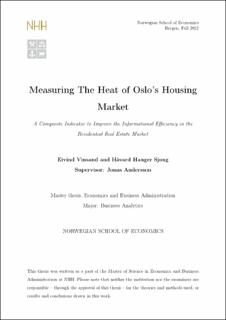| dc.description.abstract | This paper develops a composite indicator that estimates the relative bargaining power
between buyers and sellers in Oslo’s residential real estate market. It constitutes a
geometric mean of three min-max scaled indicators that measure (1) how long it takes
to sell a home, (2) the disparity between sale and listing prices, and (3) the relative
housing supply. The paper’s objective is to develop a robust measurement of market
temperature that improves the informational efficiency in the Norwegian real estate
market. We find that information on bargaining power can guide market participants with
prospecting, bid, and sales strategies. We also find that it can support decision-makers in
monitoring the impacts of policies, assessing market dynamics, and benchmarking regional
differences. Uncertainty analysis suggests that the index is generally unbiased. Variancebased
sensitivity analysis reveals normalization to be the only significant uncertainty
factor. We show that index trends coincide with Oslo’s home appreciation rates and the
media’s perception of market heat. | en_US |
